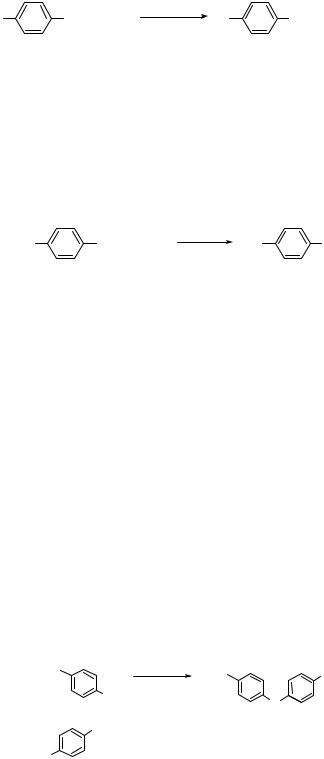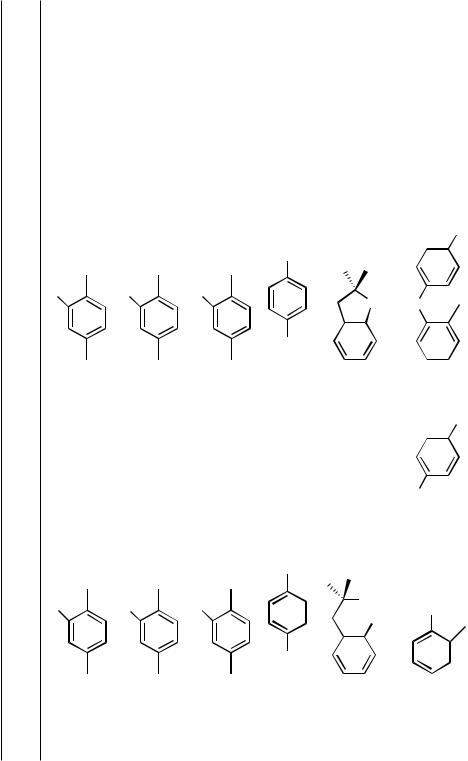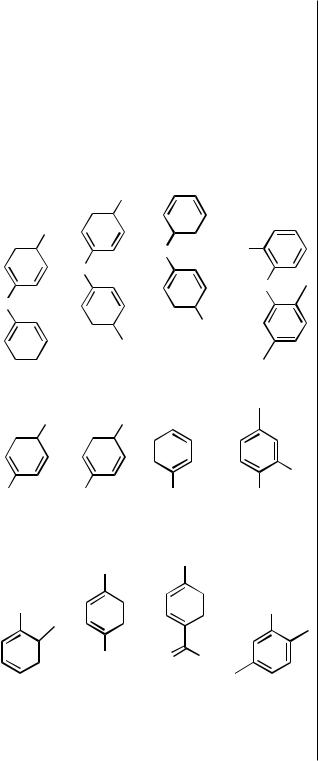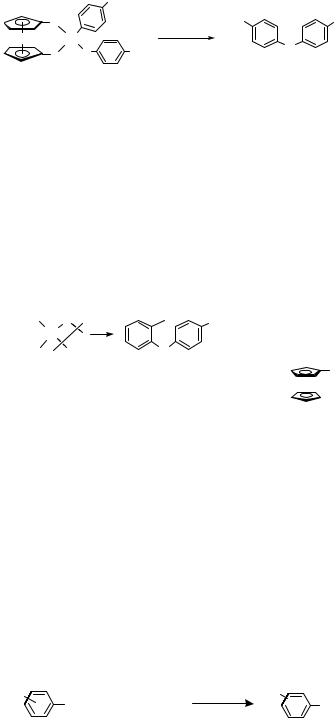

Pd
ArX  ArOR
ArOR
III.3.3 Palladium-Catalyzed Synthesis
of Aryl Ethers and Related Compounds
Containing S and Se
JOHN F. HARTWIG
A. INTRODUCTION
Pd-catalyzed aromatic C—O bond formation is less developed than Pd-catalyzed C––N bond formation. At this point, useful synthetic methods have been developed for the intramolecular formation of oxygen heterocycles,[1] the intermolecular formation of t-butyl aryl ethers,[2] which serve as protected phenols, and the intermolecular formation of diaryl ethers.[2],[3] In general, the formation of aryl alkyl ethers from alcohols that have hydrogens on the carbon to oxygen are not useful substrates for intermolecular formation of aryl ethers, at the time of manuscript preparation, except when reacting them with strongly electron-deficient aryl halides.[3] In these cases, uncatalyzed reactions can be conducted in polar solvents, although different selectivity for reaction with chloride and bromide may prove useful for particular applications. Nevertheless, the extension of the amination chemistry to the formation of aryl ethers has been achieved for some classes of substrates, and further catalyst improvements should increase the generality of these reactions.
The electrophile substrates for C—O bond formation have been divided into the following categories: electron-deficient haloarenes, unactivated haloarenes, and vinyl halides. t-Butanol, alcohols with -hydrogens, silanols, and phenols are the classes of nucleophile substrate. Table 1 shows the various ligands for palladium that have been shown to accomplish these different types of transformations as of May 15, 1999, when this section was prepared.
B. SPECIFIC EXAMPLES OF PALLADIUM-CATALYZED
C—O BOND FORMATION
B.i. Initial Studies with Arylphosphines
The initial studies on Pd-catalyzed C—O bond formation were conducted as intramolecular reactions to form oxygen heterocycles (Eq. 1). It is known that copper complexes will catalyze these transformations, and copper acetylide is particularly valuable for these
Handbook of Organopalladium Chemistry for Organic Synthesis, Edited by Ei-ichi Negishi ISBN 0-471-31506-0 ©2002 John Wiley & Sons, Inc.
1097

1098 III Pd-CATALYZED CROSS-COUPLING
TABLE 1. Effective Catalyst Systems for the Formation of Aryl Ethers from Aryl Halides
|
|
ROH |
|
|
|
t-BuOH |
(R with -H) |
R3SiOH |
ArOH |
|
|
|
|
|
ArX, Ar is |
FcP(t-Bu) |
BINAP |
DPPF/Ni(COD)2 |
FcP(t-Bu) |
activated |
Fc ferrocenyl |
|
BINAP/Pd |
Fc ferrocenyl |
|
P(t-Bu)3 |
|
|
P(t-Bu)3 |
|
BINAP, DPPF |
|
|
DPPF |
ArX, Ar is |
FcP(t-Bu) |
|
|
FcP(t-Bu) |
unactivated |
Fc ferrocenyl |
|
|
Fc ferrocenyl |
|
P(t-Bu)3 |
|
|
P(t-Bu)3 |
Vinyl-X |
|
Pd(PPh3)4 |
|
|
|
|
(only report) |
|
|
|
|
|
|
|
X
OH
R
n R
X Br, I; n 1,2,3
[Pd(OAc)2 ] (3–5 mol %) L (4 –6 mol %)
base, solvent, 80–100 C base K2CO3, NaO-t-Bu solvent toluene or dioxane L BINAP, DPPF
O R
R
n
(1)
cyclizations.[4] Nevertheless, the palladium chemistry offers an alternative procedure and gives good yields for a variety of heterocycles when the alcohol portion of the substrate is a tertiary alcohol and cannot undergo -hydrogen elimination.[1] In cases where -hydro- gen elimination can occur, good yields were obtained for aryl halides with a pendant cyclohexanol, but substrates with pendant acyclic secondary alcohols reacted in low yields. The most efficient catalysts that have been published for these reactions are palladium complexes ligated by DPPF and BINAP. Slightly lower catalyst loads were reported for DPPF complexes, and the only examples that could undergo -hydrogen elimination were performed with DPPF as ligand.
Intermolecular formation of aryl alkylethers was initially reported independently by Hartwig and Buchwald, while the formation of vinyl ethers was reported by Rossi using tin alkoxides. For all three types of reactions, activated substrates were required. Rossi and co-workers reported the formation of methyl vinyl ethers by reaction of Bu3SnOMe with activated alkenes such as 2,3-dibromopropenoates catalyzed by Pd(PPh3)4 (Eq. 2).[5] Mann and Hartwig reported reactions catalyzed by DPPF-ligated palladium complexes to form t-butyl aryl ethers from NaO-t-Bu and bromoand chloroarenes that bear electronwithdrawing groups in the p-position (R t-Bu in Eq. 3).[6] Buchwald and co-workers showed that BINAP – palladium complexes could form alkyl aryl ethers with alcohols that can undergo -hydrogen elimination when reacted with activated aryl halides (Eq. 3).[3] Reaction of NaO-t-Bu with an unactivated aryl halide was reported to give ether product in modest yield, and no reaction times were reported.[3] Similar yields after long reaction times were obtained using DPPF as ligand in unpublished work.[7]
Br |
Br |
Pd(PPh3)4 |
MeO |
Br |
|
+ MeOSnBu3 |
|
(2) |
|
H |
COOMe |
NMP, 20 C |
H |
COOR |

|
III.3.3 |
Pd-CATALYZED SYNTHESIS OF ARYL ETHERS |
1099 |
|||
R |
X + NaOR |
[Pd(dba)2], L |
R |
OR |
(3) |
|
toluene |
|
|||||
|
|
|
|
|
|
|
R |
CN, CHO, C(O)Ph |
60–80 C |
|
|
|
|
|
|
|
|
|
||
R |
alkyl, L DPPF, BINAP |
|
|
|
|
|
Subsequent work reported some improvements on this chemistry when nickel catalysts were used, particularly for the formation of silyl aryl ethers.[8] However, another approach was the use of phosphines that are weaker donors than standard triarylphosphine ligands. Use of a palladium catalyst containing a DPPF analog bearing p-CF3 groups on each phenyl ring led to improved yields as part of the first examples of Pd-catalyzed formation of diaryl ethers from aryl halides (Eq. 4).[9] Nonetheless, neither of these changes in catalyst composition led to the formation of aryl ethers from unactivated aryl halides in a synthetically valuable fashion.
Y |
X + NaOAr |
Pd(dba)2 |
/ L |
OR |
(4) |
|
R |
||||
|
|
toluene |
|
|
|
X Cl, Br |
L DPPF or CF3-DPPF |
63–92% |
|
||
Y CN, C(O)Ph, C(O)CF3 |
|
|
|
|
|
B.ii. Second-Generation Catalysts Containing Sterically
Hindered Alkylphosphines
The formation of aryl ethers from unactivated aryl halides has been published only recently[2]; subsequent catalysts based on a similar ligand design should provide further improvements. Hartwig’s group assessed the relative importance of steric and electronic properties of the ligand on the rate of C––O bond-forming reductive elimination by preparing (i) ligands with the basic DPPF structure, but containing donating and withdrawing substituents on the phosphorus aryl groups[9] and (ii) sterically hindered alkyl-substituted DPPF analogs such as bis (di-t-butylphosphino)ferrocene (DtBPF).[2] This alkylphosphine ligand showed activity for reactions of unactivated aryl halides (Eq. 5).[2] However, this ligand was shown to undergo facile P—C bond cleavage at the backbone to form two monophosphines, and the active monophosphine was shown to be ferrocenyl di-t-butylphosphine. This ligand forms palladium complexes that catalyze the synthesis of t-butyl aryl ethers from aryl halides under mild conditions and in high yields with unactivated aryl halides (entries 1–5, Table 2). Moreover, catalysts bearing this ligand mediate the formation of diaryl ethers from phenoxides and unactivated aryl halides at temperatures between 80 and 110 °C over the course of 4–12 h (entries 6–10, Table 2). Thus, the problem of -hydrogen elimination from intermediate alkoxides has not been addressed, but C—O bond formation by reductive elimination is now fast enough to allow for certain classes of valuable aryl ether syntheses.
But |
Bu |
t |
OMe |
|
cat. L/[Pd] |
|
(5) |
Br |
L Dt BPF, 45% |
O |
|
+ |
|
||
|
|
||
OMe |
L BINAP, DPPF, P(o-tolyl)3, 0% |
|
|
|
L P(t-Bu)3, 27% |
|
|
NaO |
L PhP(t-Bu)2, <5%, FcP( t-Bu)2, 83% |
||

Yield
Ligandas
3 Bu)-t P(or
2 Bu)-t FcP(Using
EthersAryl
Arylof toHalides
-Pd ConversionCatalyzed
2.TABLE
a (%)
Conditions
Product
NaOR
ArX
Entry
b |
b,c |
b,c |
|||
|
71 |
|
68 |
|
62 |
h, °C |
h, °C |
h, °C |
|||
12 |
80 |
12 |
100 |
12 |
110 |
OH |
OH |
OH |
NaO-t-Bu |
NaO-t-Bu |
NaO-t-Bu |
Cl |
Br |
I |
1 |
2 |
3 |
84 |
78 |
82 |
h, °C |
h, °C |
h, °C |
|||
6 |
80 |
3 |
80 |
9 |
80 |
Bu |
|
|
|
|
|
OMe |
||
Ot- |
|
O |
|
|
|
|
||
|
O |
|||||||
|
|
|
|
|||||
t-Bu |
|
|
|
|
|
OMe |
||
|
|
|
|
|
||||
|
|
|
|
|
||||
|
|
|
|
|
|
|
|
|
NaO-t-Bu |
|
|
|
|
|
|
||
|
|
NaO |
||||||
Br |
|
|
|
|
|
|
||
|
|
|
OH |
Cl |
||||
|
|
|
||||||
|
|
|
|
Br Bu |
||||
|
|
|
|
|||||
|
|
|
|
|
+NaO-t- |
|
|
|
t-Bu |
|
|
||||||
|
|
|
||||||
|
|
|
||||||
4 |
|
|
5 |
|
6 |
|
|
|
1100

85 |
74 |
63 |
h, |
°C |
h, °C |
h, °C |
||||||||
12 |
80 |
12 |
110 |
12 |
110 |
||||||
|
|
|
|
|
|
|
OMe |
|
|
|
|
|
|
|
OMe |
|
|
|
|
|
|
|
|
|
|
|
|
|
|
|
|
|
|
|
|
|
|
|
O |
|
|
O |
|
|
|||
|
|
|
|
|
|
|
|
||||
|
|
|
|
|
|
|
|
||||
|
|
|
|
|
|
|
|
|
|
||
O |
|
|
|
|
|
t-Bu |
|
|
|
Ph(O)C |
|
|
|
|
|
|
|
|
|
||||
|
|
|
|
|
|
|
|
|
|
||
|
|
|
|
|
|
|
|
|
|
||
|
|
|
|
|
|
|
|
|
|||
|
|
|
OMe |
|
|
|
OMe |
|
|
|
|
|
|
|
|
|
|
|
|
|
|
|
|
|
|
|
|
|
|
|
|
|
|
|
|
NaO |
NaO |
|
NaO |
|
|
|
Br |
|
|
Br |
|
Br |
t-Bu |
|
O |
|
|
|
|
|
|||
|
|
|
|||
|
|
|
Ph |
||
|
|
|
|||
|
|
|
|||
|
|
||||
7 |
8 |
|
|
9 |
|
d 81
h, °C |
|
24 |
110 |
O
OMe
NaO |
MeO |
Cl
10
All reactions were performed in toluene solvent with a 0.2–0.3 M concentration of aryl halide, 2–5 mol % Pd(dba)2, 2–5 mol % FcP(t-Bu)3, and 1.2 equiv of NaOR unless
a
|
H. |
|
2 |
|
SO |
|
3 |
|
HandCF |
|
2 |
|
CO |
|
3 |
stated. |
heating,thereactionmixturewastreatedwithCF |
otherwise |
b |
|
After |
analysisGC anwith standard.internal
bydetermined
wasYield c
purity.96%
isolatedwas in
productThe
catalyst.as
usedwere
3 Bu)-t P(%
mol5
and
2 Pd(dba)%
mol5
d
1101

1102 |
III Pd-CATALYZED CROSS-COUPLING |
B.iii. Mechanism of Palladium-Catalyzed C—O Bond Formation
No studies on the mechanism of the complete catalytic cycle for formation of aryl ethers from aryl halides have been conducted, but the elementary reactions in the cycle are likely to be similar to those in the catalytic cycle for formation of aryl amines. Oxidative addition, formation of an alkoxo complex, and reductive elimination of ether are likely to occur. It is the slow reductive elimination of ether that allows for amide complexes to form and undergo reductive elimination in the presence of t-BuO instead of undergoing reductive elimination of ether.
The electronic effects on the reductive elimination of aryl ethers from BINAP-ligated palladium complexes (Eq. 6) was studied by Widenhoefer and Buchwald.[10] Because the reductive elimination of acyclic ethers required activated palladium-bound aryl groups, the scope of the arylpalladium alkoxide complexes was limited. An example of elimination from an oxametallacycle that contained an unactivated aryl group demonstrated that the formation of cyclic ethers may become more general. Nonetheless, studies on these systems showed that the factors that control elimination of ethers are similar to those that control elimination of amines. For example, alkoxide complexes that are more electron rich at the alkoxide oxygen underwent faster reductive elimination than those that are more electron poor. Elimination of diaryl ethers from arylpalladium phenoxides did not occur.
|
|
EWG |
|
Ph |
2 |
|
R |
P |
|
NaO-R |
|
Pd |
EWG |
O |
|
P |
O |
R |
(6) |
|
|||
Ph2 |
R t-Bu, CH2-t-Bu |
|
|
|
|
|
|
EWG 4-CN, NO2 , C(O)Ph, 3-NO2
Next, a positive -value was observed when the substituents on the palladium-bound aryl group were varied, and the -value was much larger than that observed with amines. Only a few substituents were studied, however, and they had a limited range of -values because of the limited scope of the reaction. However, the limited scope of the catalytic reactions is consistent with this result, and one way to view the scope of aromatic substitution is by the magnitude of an electronic parameter such as the -value.
Also, two pathways were detected, one involving simple first-order elimination and a second proposed to be a second-order pathway involving attack of nucleophile on the aryl alkoxo complex, perhaps at the ipso carbon of the activated aryl group. The alkoxides were generated in situ and not isolated, and the rate of elimination depended on the amount of excess alkoxide added. Studies on phenoxo complexes show no such effect of added phenoxide,[7] and the ability to observe eliminations with unactivated aryl groups indicates that this pathway is a special case, if it does give rise to the observed kinetic data.
As part of the studies of ligand effects on the reductive elimination of diaryl ethers, arylpalladium phenoxide complexes containing a DPPF analog that had p-CF3 substituents on each of the ligand aryl groups was prepared. This CF3 –DPPF complex underwent reductive elimination of diaryl ether only twice as fast as the simple DPPF complex (Eq. 7).[7]

|
III.3.3 Pd-CATALYZED SYNTHESIS OF ARYL ETHERS |
1103 |
|||
|
CN |
|
|
|
|
Ar2 |
|
NC |
R |
|
|
P |
|
|
|
||
Fe |
Pd |
|
PhCCPh |
|
(7) |
|
110 C |
O |
|||
P |
O |
R |
|
||
k |
|
|
|||
Ar2 |
|
61–95% |
|
||
|
|
|
|||
Ar = Ph, C6H4-4-CF3 |
k CF3-DPPF 2 k DPPF |
|
|
||
Steric properties of the ligand had a more pronounced effect on the rate of reductive elimination. Arylpalladium phenoxide complexes containing a sterically hindered monophosphine P(Fc)(t-Bu)2 (Fc ferrocenyl) underwent reductive elimination of diaryl ethers, even when the palladium-bound aryl group was unactivated.[2] Arylpalladium phenoxide intermediates containing P(t-Bu)3 as ligand underwent this reductive elimination in essentially quantitative yield. Reductive elimination of diaryl ether from DPPF-ligated palladium complexes with unactivated aryl groups on the metal did not occur. Thus, the steric hindrance of the ligand and the presence of a single phosphine donor atom provide large rate accelerations.
o-tol |
C6 H4-p-OMe |
|
OMe |
|
|
|
O |
|
|
|
|||
|
Pd |
L |
|
+ L2Pd |
|
|
L |
2 |
O |
|
(8) |
||
|
|
|||||
L FcP(t-Bu) |
, L P(t-Bu) |
95% |
FcP( t-Bu) |
|
P( t-Bu)2 |
|
|
2 |
3 |
25% |
2 |
Fe |
|
L L FcP(t-Bu)2 |
|
|||||
|
|
|
||||
L L PPh3 |
|
0% |
|
|
|
|
C PALLADIUM-CATALYZED C—S AND C—Se BOND FORMATION
C.i. Palladium-Catalyzed Cross-Coupling of Thiolates with Aryl and Vinyl Halides
The Pd-catalyzed formation of C—S bonds was conducted before the Pd-catalyzed C—N, C—O, or C—P bond formations. In 1978 and 1980 Migita and co-workers reported the coupling of aryl bromides and iodides with thiols in the presence of alkoxide base as shown in Eq. 9.[11],[12] Both alkyl and aryl thiols were studied and gave good yields of arylsulfide product. The catalyst was Pd(PPh3)4, and reactions were conducted in DMSO, DMF, acetonitrile, and alcohol solvents. The optimal solvent depended on the reaction conducted. These reactions provided the arylsulfide in high yields, except for the reaction of 2,6-dimethyl-substituted aryl halides, which gave lower yields. Subsequently, they reported a similar method using stannylsulfide instead of thiols and amines. In a review of
R |
X + RSH + NaO- t-Bu |
Pd(PPh3)4 |
R |
|
DMSO |
SR |
|
|
|
(9) |
|
|
|
|
|
X Br, I |
R Ph, Et, t-Bu, n-Bu |
|
75–100% |
|
|
R H, m -, o-, p-CH3, m -, o-, p- CH3O, p -Cl

1104 |
III Pd-CATALYZED CROSS-COUPLING |
Pd-catalyzed cross-coupling of organic halides,[13] Beletskaya reported a method for synthesizing symmetrical diarylsulfides involving the reaction of 2 equiv of aryl halide with (Et3Sn)2S as nucleophile, and Widdowson and co-workers compared the palladium chemistry with the substitution mediated by coordination of the arene to the tricarbonylchromium(0) fragment.[14] The catalytic method is certainly more valuable on a large scale, and the catalytic method involving thiols and base would generally be preferred over that involving toxic tin reagents; the high acidity of thiols allows bases that are milder than NaO-t-Bu to be used when sensitive functionality is present.
Most recently, Zheng and co-workers from Merck Process Research reported the extension of this chemistry to the reactions of aryl triflates. In this case, some catalyst screening was necessary to observe high yields of arylsulfide product. In their hands, a combination of Pd(OAc)2 and Tol-BINAP was the most effective catalyst, and NaO-t-Bu was the most effective base for the formation of t-butyl arylsulfides from aryl triflates. Isolated yields ranged from 54% to 93%, and a variety of functionality was tolerated, including donating and strongly withdrawing groups on the aryl triflate.
Polyphenylene sulfide is a particularly useful engineering plastic.[15] In 1984 Asahi Glass obtained patents on the use of palladium and nickel complexes to form this polymer.[16],[17] Although the direct high-temperature synthesis of Na2S and PhCl is still used commercially, high-purity polymer from the metal-catalyzed chemistry may become important for electronic applications, and the palladium chemistry allows for controlled synthesis of oligomers. Recently, Gingras and co-workers reported the use of Pd-catalyzed thiation to form discrete phenylene sulfide oligomers.[18],[19] A number of polyphenylene sulfide wires ranging from dimeric to pentameric structures were prepared by palladium chemistry, albeit in modest yields. These oligomers were combined with a polyhalogenated core in a direct thermal substitution to prepare branched structures.
Other sulfur nucleophiles can be used in the metal-catalyzed C—S bond-forming chemistry. Takagi, Iwachido, and Hayama reported the reaction of aryl halides with thioamide nucleophiles to produce 2-alkylbenzothiazoles, as shown in Eq. 10.[20] The presence of CaO base increased the yield significantly, and the use of phosphorus ligands increased the turnover numbers of the catalysts. This chemistry tolerated 2-CH3, 2-CH2OCH3, 2-CH2CN, 4-Br, 5-Cl, 5-CH3, and 5-CF3 substitution of the iodo aniline, but not 2-aryl substitution.
I |
Base |
S C |
NH |
|
+ CH3CSNH |
||||
2 |
CH3 |
|||
NH2 |
Pd (0) |
|||
|
catalyst |
NH2 |
(10) |
|
S
CH3
N
Vinyl sulfides are valuable synthetic intermediates.[21] Several examples of crosscoupling reactions between vinyl halides and sulfur nucleophiles have been reported. Beletskaya reported the stereospecific coupling of distannylsulfides with vinyl halides,[13] while Murahashi reported a similar reaction but using alkali thiolates (Eq. 11).[22]-Bromostyrene was converted to (2-phenyl-ethenylthio) benzene in 95% yields and

|
III.3.3 Pd-CATALYZED SYNTHESIS OF ARYL ETHERS |
1105 |
|
Ph |
Pd(PPh3)4 |
Ph |
|
+ |
RSLi |
|
(11) |
Br |
R Ph or Et |
SR |
|
|
93–98% |
|
|
|
|
|
|
100% isomeric purity
with 100% isomeric purity. Sodium thiolates were also coupled successfully with-bromostyrene. Carpita, Rossi, and Scamuzzi showed that Pd(PPh3)4-catalyzed reactions can be used to selectively couple thiolates with trans- over cis-1-alkenyl bromides.[23] In competition studies, trans-alkenes underwent cross-coupling more rapidly than the corresponding cis-alkenes.
C.ii. Palladium-Catalyzed C—Se Bond Formation
Little C—Se bond formation by palladium catalysis has been reported, although these reactions should be feasible considering the ability of palladium complexes to catalyze C—S, C—P, and C—As bond formation. However, nickel complexes have been used for carbon – selenium bond formation. In 1985, Cristau and co-workers used bis(bipyridyl)nickel(II) bromide to form aryl selenides from aryl halides and sodium benzeneselenoate.[24]
D. FUTURE PROSPECTS
Pd-catalyzed formation of aromatic C—S bonds is a more straightforward transformation to conduct than related aromatic carbon – heteroatom bond formation. The reaction can be conducted with a variety of simple ligand systems and yields are often high; weak C"S bonds make -hydrogen elimination unfavorable, and the nucleophilicity of thiolates makes C —S bond-forming reductive elimination rapid. This chemistry provides a reliable synthetic method that should see increased use in synthetic chemistry in the future. In contrast, Pd-catalyzed formation of carbon – oxygen bonds requires special ligand systems. A number of aromatic C—O bond-forming processes have now been published, but for general use in synthesis, new catalysts will need to be developed. This class of Pdcatalyzed C—X bond formation is, therefore, the least developed. Yet, the synthetic value and recent progress make it likely that significant advances will be seen in the future.
REFERENCES
[1]M. Palucki, J. P. Wolfe, and S. L. Buchwald, J. Am. Chem. Soc., 1996, 118, 10333.
[2]G. Mann, C. Incarvito, A. L. Rheingold, and J. F. Hartwig, J. Am. Chem. Soc., 1999, 121, 3224.
[3]A. Aranyos, D. W. Old, A. Kiyomori, J. P. Wolfe, J. P. Sadighi, S. L. Buchwald, J. Am. Chem Sec., 1999, 121, 4369.
[4]C. E. Castro, R. Havlin, V. K. Honwad, A. Malte, and S. Mojé, J. Am. Chem. Soc., 1969, 91, 6464.
[5]R. Rossi, F. Bellina, and L. Mannina, Tetrahedron, 1997, 53, 1025.
[6]G. Mann and J. Hartwig, J. Am. Chem. Soc., 1996, 118, 13109.
1106 |
III Pd-CATALYZED CROSS-COUPLING |
[7]G. Mann and J. F. Hartwig, unpublished results.
[8]G. Mann and J. F. Hartwig, J. Org. Chem., 1997, 62, 5413.
[9]G. Mann and J. F. Hartwig, Tetrahedron Lett., 1997, 38, 8005.
[10]R. A. Widenhoefer and S. L. Buchwald, J. Am. Chem. Soc., 1998, 120, 6504.
[11]M. Kosugi, M. Kameyama, and T. Migita, Chem. Lett., 1983, 927.
[12]M. Kosugi, M. Kameyama, H. Sano, and T. Migita, Nippon Kagaku Kaishi, 1985, 3, 547.
[13]I. P. Beletskaya, J. Organomet. Chem., 1983, 250, 551.
[14]M. J. Dickens, J. P. Gilday, T. J. Mowlem, and D. A. Widdowson, Tetrahedron, 1991, 47, 8621.
[15]J. W. Cleary, Polym. Sci. Technol., 1985, 31, 187.
[16]K. K. Asahi Glass, Chem. Abstr., 1984, 100, 192566s.
[17]K. K. Asahi Glass, Chem. Abstr., 1984, 100, 192567t.
[18]A. Pinchart, C. Dallaire, and M. Gingras, Tetrahedron Lett., 1998, 39, 543.
[19]M. Gingras, A. Pinchart, and C. Dallaire, Angew. Chem. Int. Ed. Engl., 1998, 37, 3149.
[20]K. Takagi, T. Iwachido, and N. Hayama, Chem. Lett., 1987, 839.
[21]B. A. Trofimov and B. A. Shainyan, in The Chemistry of Sulfur Containing Functional Groups, S. Patai and Z. Rappoport, Eds., Wiley, New York, 1993, 659–797.
[22]S. I. Murahashi, M. Yamamura, K. Yanagisawa, N. Mita, and K. Kondo, J. Org. Chem., 1979, 44, 2408.
[23]A. Carpita, R. Rossi, and B. Scamuzzi, Tetrahedron Lett., 1989, 30, 2699.
[24] H. J. Cristau, B. Chabaud, R. Labaudiniere, and H. Christol, Organometallics, 1985, 4, 657.
